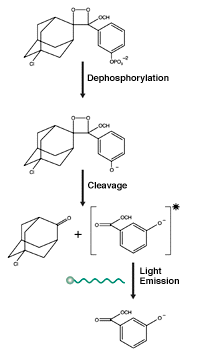Post Electrophoretic Analysis
Immunostaining with Alkaline Phosphatase
Alkaline phosphatase catalyzes the removal of a phosphate group from its substrate. A variety of synthetic substrates have been constructed which, on phosphate hydrolysis, liberate chromogens or luminescent compounds. A commonly used chromogenic substrate is bromochloroindoyl phosphate. (BCIP) in conjunction with nitro blue tetrazolium (NBT). Dephosphorylation of BCIP generates one half of an indigo dye molecule. Dimerization generates the indigo dye, and liberates two reducing equivalents which can reduce NBT to the blue insoluble formazan. This system generates a deep blue insoluble dye, which is ideally suited for the blotting procedures described below. Alternatively, PNPP (para nitrophenyl phosphate) is hydrolyzed to liberate a soluble yellow dye, useful for ELISA reactions.

Mechanism of light emission by CSPD, a luminescent substrate for use with alkaline.
Luminometric substrates for alkaline phosphatase are exemplified by CSPD (ChloroPhosphoPhenyl Dioxetane) (see figure below). Upon dephosphorylation, this material yields a metastable charged dioxetane which then cleaves, releasing a highly energetic chlorophenylate. This molecule decays within 1 minute to a ground state, releasing light of wavelength 466 mm.
NEXT TOPIC: Immunostaining with Horseradish Peroxidase
- UV Shadowing
- Uneven Staining
- Staining Proteins Immobilized on Membranes
- Staining Protein Gels with Coomassie Blue
- Southern Blotting
- Smeared Bands
- Silver Staining Protein Gels
- Silver Staining DNA Gels
- Protein Fixation on Gels
- Post-Electrophoretic Visualization with Nuclistain
- Overview of Western Blotting
- Northern Blotting
- Method for Western Blotting
- Mechanism of Immunostaining
- Mechanism of Immunostaining
- Immunostaining with Alkaline Phosphatase
- Guide Strip Technique
- Faint bands, low background
- Faint Bands, High Background
- Ethidium Bromide Staining
- Enzyme Linked Immunosorbent Assay (ELISA)
- Coomassie Blue Stain- Troubleshooting
- Blotches on Gel
- Autoradiography
- Autoradiographic Enhancement with Autofluor
- An Overview of Northern and Southern Blotting
- Alkaline Blotting
